Data from Rambam hospital in Haifa reveal a stillbirth, miscarriage and abortion (SBMA) rate of 6% among women who never received a COVID-19 vaccine, compared to 8% among women who were vaccinated with at least one dose (and never had a SARS-Cov-2 infection).1
That’s a statistically significant odds ratio of 1.36 (CI 1.0-1.9), meaning your odds of having a stillbirth, abortion or miscarriage are 1.36 times higher if you are vaccinated.2
Another way of putting it is that the SBMA rate among vaccinated women was nearly 34% higher than the rate among unvaccinated women. This difference is statistically significant at the 95% confidence interval based on a Chi-square test of significance.
One possible explanation is that older women and women with co-morbidities were more likely to get vaccinated, and that explains the difference. It’s possible, but it has to be shown. This paper recently published in JAMA on live births based on Israeli electronic medical records shows that vaccinated and unvaccinated mothers were in many ways very similar. Vaccinated women were only about 1 year older on average than unvaccinated women in terms of average age (30.5 vs. 31.6 yrs) and if anything, the unvaccinated mothers were less healthy: more of them were obese and smoked; and they were far more likely to have had a SARS-Cov-2 infection during pregnancy.
But regardless of what reason for these differences is, the signal in these data are too strong and the issue too important to be dismissed with hand-waving arguments based on conjecture. That would be reckless.
We can get some purchase on the “unhealthy vaccinee” hypothesis by looking at the trend over time. If younger, healthier women were less likely to be vaccinated, then the differences across months should be fairly stable. But the differences are actually quite striking.
The bar chart below shows what percentage of births among vaccinated women were SBMA and what percentage were live births, and compares this to the percentage among unvaccinated women. (Vaccinated means the women had received at least one dose of the Pfizer/BioNTech COVID-19 vaccine.)3
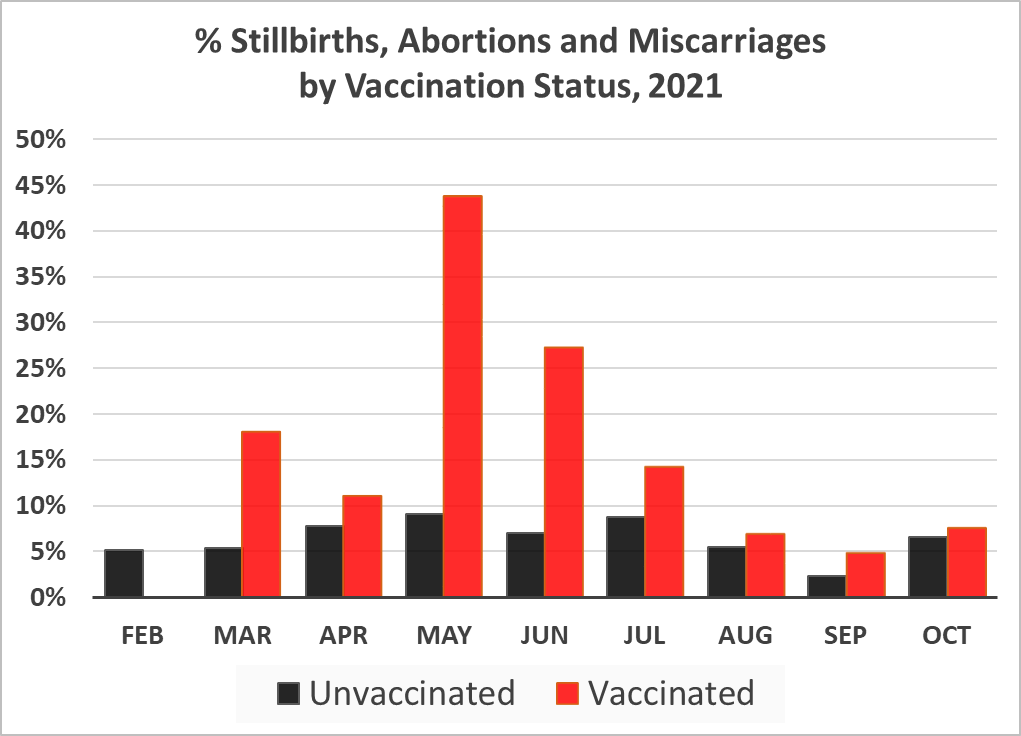
The SBMA rate among vaccinated women was higher than the rate among unvaccinated women for every month except for February, which was at the very beginning of the vaccination campaign for pregnant women when only 2 births were recorded for vaccinated women. The rate reached a peak in May, with 44% of vaccinated women experiencing a stillbirth, miscarriage or abortion that month, compared to 9% among unvaccinated women. In other words, of all the recorded pregnancy outcomes among vaccinated women in May, 43% were either stillbirth, miscarriage or abortion.
But if the difference is explained by older, less healthy pregnant women more likely to get vaccinated, then we would expect the increase among the vaccinated to be offset by a decrease in the unvaccinated. But if we put the two groups together and look at trends over time, we still see a large increase:
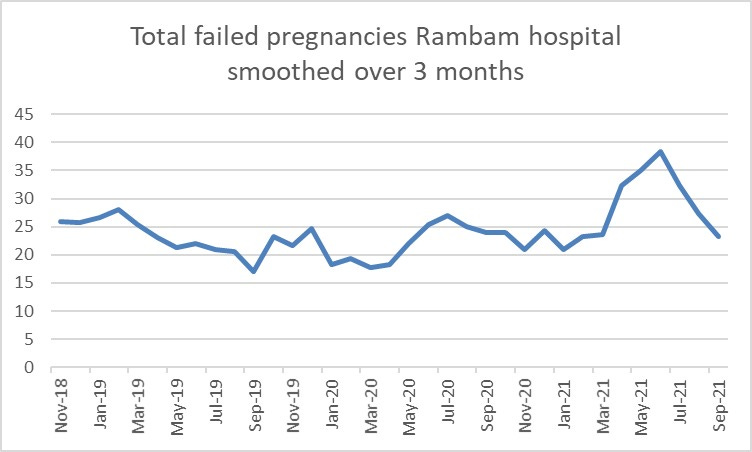
Furthermore, if older, less healthy women were more likely to get vaccinated, then we would not expect to see this degree of variation over the year. If anything, we would expect to see the highest counts in Feb-April when women at higher risk for Corona would have been among the first in line to get vaccinated, according to this alternative explanations.
This is affirmed by data on vaccinations from the Israeli Ministry of Health. Below is a graph from the MoH showing vaccination rates from the beginning of the vaccination drive in December, 2020. Dark green is first dose, light green is second dose:
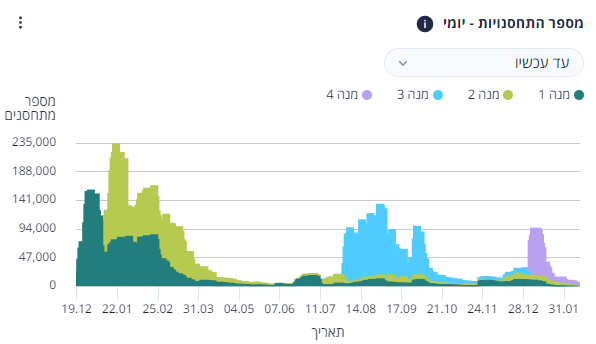
We can see that the overall vaccination rate began dropping precipitously in March and was very low in May. Furthermore, the differences in the SBMA rate between vaccinated and unvaccinated women for April, May and June are all statistically significant. In fact, the difference in May is likely to be observed by chance less than 1 in 100,000 times. (There was nothing special about May in terms of tight lockdowns or restrictions — in fact, the government started lifting restrictions and life was starting to get back to normal.) The other months would be statistically significant if the N was a bit larger. But alas, we only have data from one hospital.
Actually, that’s not entirely true. The activists who filed the FOIA request from Rambam also got information from another hospital, Sheba medical center. However, Sheba did not have information on vaccination status for a large number of women, so we can’t reliably compare vaccinated versus unvaccinated. But we can look at the SBMA rate this year compared to previous years, both for Sheba and Rambam. (Note that Sheba has a much higher baseline SBMA rate, for reasons that are not entirely clear. The serve very different populations, and Sheba may simply perform more elective abortions every year than Rambam.)
The graphs below show the SBMA rate at each hospital in 2019, 2020 and 2021 over 3 different time periods: January-October, March-October and April-June.
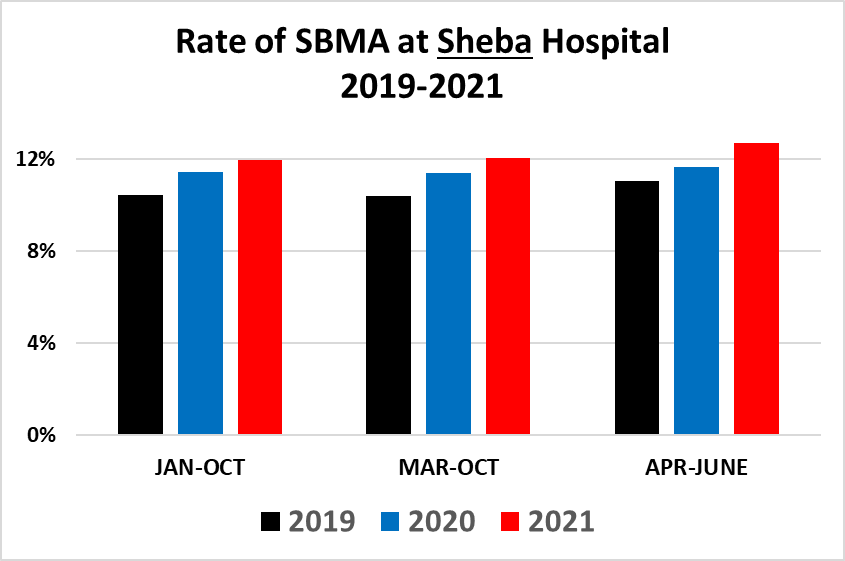
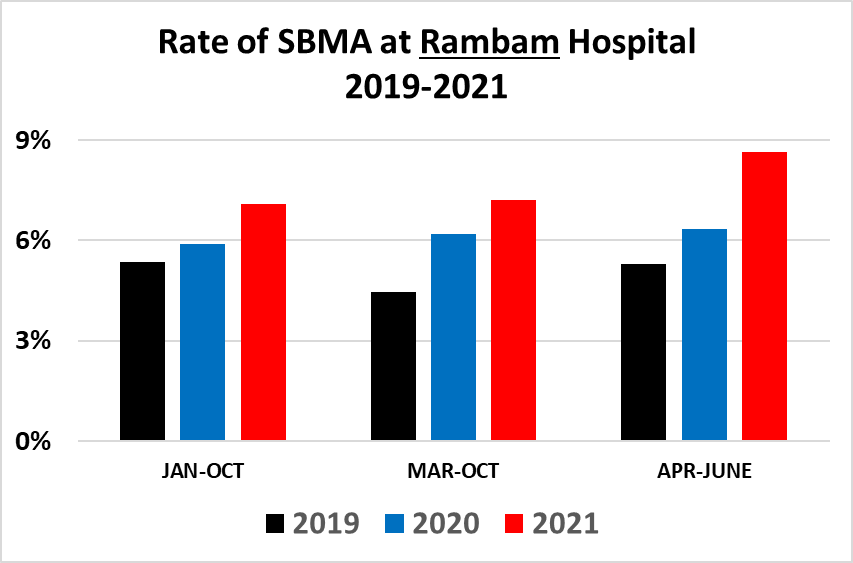
The SBMA rate is higher in both hospitals in 2021 compared to the previous years. Notably, April to June — which was the period with the highest (and statistically significant) rates of SBMA among the vaccinated at Rambam hospital — are also much higher at Sheba. At Rambam, the rate over that period is 8.7% versus an average of 5.7% for 2019-2020, which is 50% higher. At Sheba, the SBMA rate in 2021 for April-June is 12.7%, versus an average of 11.3% for 2019-2020, which is 12% higher.
In May, 2021, Rambam had 42 SBMAs, which was nearly double the average of the May total from the previous two years and 30% higher than the highest number of any month in the previous two years, which was 32 in June of 2020.
Sheba had its highest SBMA count in June, with 146. That was 30% higher than the average of the previous 2 years, and 11% higher than the largest number of SBMAs for any month in the previous 2 years, which was 132 in March, 2019.
And again: since these comparisons include both vaccinated and unvaccinated women, the difference cannot be due to older, less healthy women being vaccinated.
So to boil it down: in 2 different Israeli hospitals, 2021 has witnessed significantly higher rates of stillbirths, miscarriages and abortions than the previous two years, with some months setting a record for the number of SBMAs compared to 2019 and 2020. For the one hospital where we do have data comparing vaccinated to unvaccinated women, the rate of SBMAs among vaccinated women is 34% higher than among unvaccinated women.
I would be amiss not to discuss what the data say about women who had a SARS-CoV-2 infection during pregnancy. There were 7 such women who gave birth during this period, with 2 of them experiencing stillbirths or miscarriage. This is an odds-ratio of 6.2 (CI 1.2-32.3).
While this odds ratio is much higher than the ratio for vaccinated women, the percentage of all women in this hospital who had a SARS-CoV-2 infection during pregnancy was extremely low (0.17%), and so the overall risks of a miscarriage or stillbirth due to coronavirus infection are clearly outweighed by the risk to vaccinated pregnant women who have a 100% chance of being vaccinated — assuming vaccination is the driver of these differences. (There were 6 additional women who had COVID prior to pregnancy, all of whom had live births.)
In a sane world, this data would be Earth-shaking. The Israeli Ministry of Health would immediately stop vaccinating pregnant women against COVID-19 and launch a thorough investigation. Can we say for sure that vaccines are the cause of these patterns? No. Not with these data. But nobody can say for sure that the vaccines played no role. But the precautionary principle along with the oath to “First, do no harm” demand that action be taken. But since we don’t live in a sane world, that won’t happen. Instead the news will be greeted with quick, careless dismissals based on hand-waving arguments based on conjecture. 1
The data were provided to Israeli activists who file FOIA requests. See these links for more information in Hebrew from two of the people involved, Ori Xabi and Oz Koren. The raw data provided by the hospitals is available here.2
But nobody can say for sure that the vaccines played no role. But the precautionary principle along with the oath to “First, do no harm” demand that action be taken. But since we don’t live in a sane world, that won’t happen. Instead the news will be greeted with quick, careless dismissals based on hand-waving arguments founded on assumptions and conjecture.

